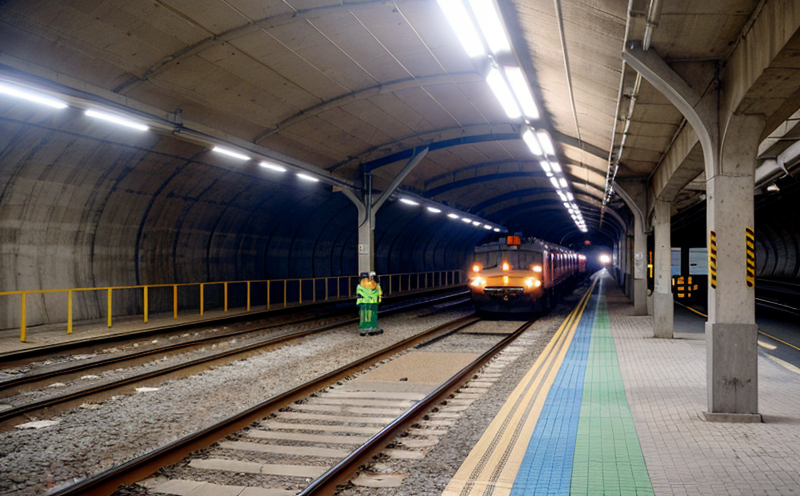EN 14067 Aerodynamic Pressure Load Testing in Tunnels
The EN 14067 standard provides a robust framework for assessing aerodynamic pressure load characteristics within tunnels. This testing is critical for ensuring the structural integrity and operational safety of tunnel infrastructure, particularly under dynamic loading conditions such as high-speed trains or wind gusts.
Aerodynamic pressure loads can significantly impact the performance of tunnel structures, including portals, ventilation shafts, and support systems. The EN 14067 standard outlines comprehensive procedures to quantify these pressures, allowing for accurate design and maintenance decisions that enhance both safety and efficiency.
The testing procedure involves placing a model in a wind tunnel or a similar facility where controlled wind speeds simulate real-world conditions. The objective is to measure the aerodynamic forces acting on the structure during various speed increments. This data is then analyzed using finite element analysis (FEA) software to predict stress levels and potential failure points.
For effective testing, it's essential to prepare specimens accurately. This includes cleaning the tunnel model thoroughly to eliminate any external factors that could distort results. Calibration of all instruments used in measurement ensures precision and reliability. During the test, real-time data collection is crucial for capturing detailed pressure distribution patterns across different parts of the structure.
The testing process not only helps identify areas requiring reinforcement but also aids in optimizing design parameters to withstand future operational loads more effectively. By adhering strictly to EN 14067 guidelines, laboratories can provide comprehensive reports that meet international standards, thereby enhancing trust among stakeholders.
- Customer Impact: Ensures compliance with international regulations, improves safety, and enhances structural integrity.
- Satisfaction: Provides accurate data for informed decision-making, reduces risk of structural failure, and supports long-term infrastructure sustainability.
In summary, EN 14067 testing is indispensable in the railway and transportation sector, especially when dealing with complex tunnel environments. It offers a structured approach to understanding aerodynamic pressures, which are crucial for maintaining safe and efficient tunnel operations.
Why It Matters
The significance of EN 14067 testing cannot be overstated in the context of railway and transportation infrastructure. Tunnel structures subjected to high-speed trains or severe weather conditions must endure significant aerodynamic pressure loads. Accurately measuring these pressures helps prevent structural failures, which could lead to catastrophic accidents.
By conducting thorough EN 14067 tests, engineers can identify weak points in tunnel designs and implement necessary modifications before they become critical issues. This proactive approach ensures that tunnels remain safe for both passengers and staff while optimizing their operational efficiency.
The standard's importance extends beyond mere compliance with regulatory requirements; it represents a commitment to excellence in engineering practice. Compliance officers, quality managers, and R&D engineers rely on such testing to ensure consistent product performance across all stages of development and deployment.
Moreover, EN 14067 supports the broader goal of sustainable infrastructure by promoting longevity and reliability through precise load assessments. This aligns with global efforts towards creating more resilient transportation networks capable of enduring changing environmental conditions.
In conclusion, adhering to the EN 14067 standard is vital for maintaining high standards in tunnel design and construction. It ensures that all elements contribute effectively towards achieving safe, efficient, and sustainable railway systems.
Customer Impact and Satisfaction
- Achieve Compliance: Ensures that all tests meet international regulatory requirements, providing peace of mind for clients.
- Enhance Safety: Identifies potential hazards early in the development process, reducing risks associated with structural failures.
- Promote Efficiency: Optimizes design parameters based on accurate load data, leading to more effective use of resources.
- Increase Trust: Provides reliable and consistent test results that build confidence among stakeholders.
- Support Decision-Making: Offers detailed insights into the performance characteristics of tunnel structures, aiding informed choices about upgrades or new projects.
- Encourage Innovation: Encourages continuous improvement in engineering practices through rigorous testing protocols.
- Sustain Longevity: Ensures that tunnels are built to last, enhancing their overall value over time.
The impact of EN 14067 testing reaches far beyond mere compliance; it plays a pivotal role in shaping the future of safe and sustainable railway infrastructure. By prioritizing this standard, clients can expect enhanced reliability, reduced maintenance costs, and extended operational lifespans for their tunnel assets.
International Acceptance and Recognition
The EN 14067 standard is widely recognized across Europe and beyond as a benchmark for aerodynamic pressure load testing in tunnels. Its acceptance by various countries underscores its relevance and applicability to diverse climates, geographies, and operational environments.
Many nations have adopted this standard due to its comprehensive approach to addressing complex tunnel structures' unique challenges. For instance, in regions prone to extreme weather conditions or high-speed train traffic, adhering to EN 14067 ensures that tunnels are designed and constructed with robustness in mind.
The European Union has embraced the standard as part of its broader initiative towards safer and more efficient transportation systems. This commitment reflects a shared vision among member states to prioritize public safety and environmental sustainability through advanced engineering practices supported by rigorous testing standards like EN 14067.
Similarly, organizations such as the International Organization for Standardization (ISO) acknowledge the value of EN 14067 in promoting best practices globally. By aligning with this standard, laboratories contribute to a harmonized approach towards tunnel engineering across different jurisdictions worldwide.
In summary, the international recognition of EN 14067 reflects its growing importance within the railway and transportation sectors. As more countries adopt and implement this standard, it continues to establish itself as a cornerstone for achieving excellence in tunnel design and construction globally.





